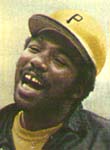 Manny Sanguillen Manny Sanguillen
Catcher
Speedy for a catcher, free-swinging Manny Sanguillen had great hitting ability, a strong arm, and a cat-like quality behind the plate. The ever-smiling Panamanian twice finished third in the NL batting race: in his second full season (1970), when he batted .325, and again in 1975, when he hit a career-high .328. The bad-ball-hitting Sanguillen was a good contact hitter, but rarely walked. Overshadowed by Johnny Bench, he edged out the Cincinnati catcher on TSN's NL All-Star Team in 1971 - the only time between 1967 and 1975 that Bench was not selected. He was durable, catching more than 100 games in seven of his first eight full seasons with the Pirates. The exception was 1973, the season after his close friend, Roberto Clemente, was killed in an airplane crash; Sanguillen was chosen to replace Clemente in right field. The move did not work and Sanguillen returned to catching. After playing for five division-champion Pirate clubs, Sanguillen was sent with $100,000 to Oakland for Chuck Tanner in a rare player-for-manager trade on November 5, 1976. Pittsburgh reacquired the popular Sanguillen in April 1978. His pinch single with two out in the ninth in Game Two of the 1979 World Series gave the Pirates a 3-2 victory.
|
 KANSAS
CITY ROYALS
KANSAS
CITY ROYALS Terry Hughes
Terry Hughes